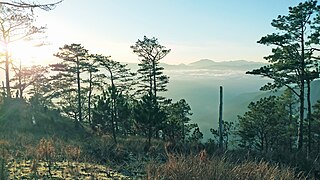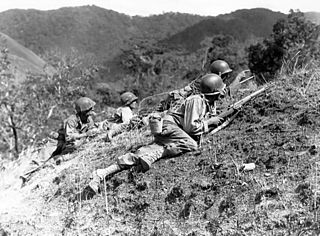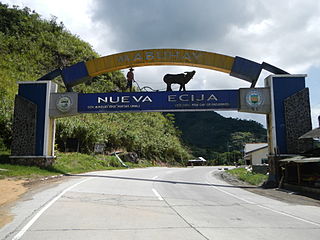
La Union, officially the Province of La Union, is a coastal province in the Philippines situated in the Ilocos Region on the island of Luzon. The province's capital, the City of San Fernando, is the most populous city in La Union and serves as the regional center of the Ilocos Region.

San Fernando, officially the City of San Fernando, is a component city and the capital of the province of La Union, Philippines. It is a coastal city consisting of fifty-nine (59) barangays and covers an area of 105.26 square kilometers. According to the 2020 census, the city has a population of 125,642. San Fernando serves as the gateway to trade and commerce to the North and the culture and heritage of Ilocandia.

The 37th Infantry Division was a unit of the United States Army in World War I and World War II. It was a National Guard division from Ohio, nicknamed the "Buckeye Division". Today, its lineage is continued through the 37th Infantry Brigade Combat Team, with battalions from Ohio, Michigan, and South Carolina.

Cervantes, officially the Municipality of Cervantes, is a municipality in the province of Ilocos Sur, Philippines. According to the 2020 census, it has a population of 19,449 people.

Tagudin, officially the Municipality of Tagudin, is a municipality in the province of Ilocos Sur, Philippines. According to the 2020 census, it has a population of 41,538 people.

Atok, officially the Municipality of Atok,, is a municipality in the province of Benguet, Philippines. According to the 2020 census, it has a population of 19,218 people.

The Battle of Luzon was a land battle of the Pacific Theater of Operations of World War II by the Allied forces of the U.S., its colony the Philippines, Mexico, and allies against forces of the Empire of Japan. The battle resulted in a U.S. and Filipino victory. The Allies had taken control of all strategically and economically important locations of Luzon by March 1945, although pockets of Japanese resistance held out in the mountains until the unconditional surrender of Japan. While not the highest in U.S. casualties, it is the highest net casualty battle U.S. forces fought in World War II, with 192,000 to 217,000 Japanese combatants dead, 8,000 American combatants killed, and over 150,000 Filipinos, overwhelmingly civilians who were murdered by Japanese forces, mainly during the Manila massacre of February 1945.

Artemio Ricarte y García was a Filipino general during the Philippine Revolution and the Philippine–American War. He is regarded as the Father of the Philippine Army, and the first Chief of Staff of the Armed Forces of the Philippines though the present Philippine Army descended from the American-allied forces that defeated the Philippine Revolutionary Army led by General Ricarte. Ricarte is notable for never having taken an oath of allegiance to the United States government that occupied the Philippines from 1898 to 1946.

John Hay Air Station, more commonly known as Camp John Hay, was a military installation in Baguio, Philippines.

Eulogio Balauitan Balao was a Filipino soldier and politician.

Dalton Pass, also called Balete Pass, is a zigzag road and mountain pass that joins the provinces of Nueva Ecija and Nueva Vizcaya, in central Luzon island of the Philippines. It is part of Cagayan Valley Road segment of Pan-Philippine Highway.

Russell William Volckmann was a graduate of the United States Military Academy at West Point, a U.S. Army infantry officer and a leader of the Philippine Commonwealth military and guerrilla resistance to the Japanese conquest of the Philippines during World War II. After the war, he remained in the U.S. Army and helped create the U.S. Army Special Forces. Volckmann, together with Colonels Aaron Bank and Wendell Fertig are considered the founders of the U.S. Army Special Forces. He eventually retired as a brigadier general.

The Battle of Baguio occurred between 21 February and 26 April 1945 and was part of the greater Luzon campaign during the Allied liberation of the Philippines at the end of World War II. During the battle, American and Philippine forces recaptured the city of Baguio on the island of Luzon from a Japanese occupation force. One of the last tank engagements of the Philippine campaign took place during the battle. Baguio later became the scene of the final surrender of Japanese forces in the Philippines in September 1945.

Mount Data is a mountain located in the Cordillera Central mountain range rising to a height of 2,310 metres (7,580 ft) in the north of Luzon Island, Philippines. It is about 100 kilometres (62 mi) north of Baguio on the borders of the provinces of Benguet and Mountain Province along the Halsema Highway. The mountain and surrounding area has been declared a national park since 1936. In 1940 the park was expanded to 5,513 hectares. The slopes of the mountain are covered with pine forests and mossy oak forests.
The United States Army Forces in the Philippines – Northern Luzon or United States Armed Forces in the Philippines – Northern Luzon (USAFIP-NL) was the military and guerrilla organization active in the Philippines after the Japanese occupation. It was made up of United States Army and Philippine Army soldiers, reservists and civilian volunteers.

The Bessang Pass Natural Monument is a protected area and memorial that commemorates the victory on June 14, 1945, by Filipino soldiers serving the U.S. Army Forces in the Philippines Northern Luzon (USAFIP-NL) over the Imperial Japanese Army in the Battle of Bessang Pass which led to Japan's eventual surrender and end to World War II in the Philippines. It covers an area of 693.32 hectares and a buffer zone of 427.79 hectares in the municipality of Cervantes in Ilocos Sur. The mountain pass was initially a component of the Tirad Pass National Park, declared in 1938 through Proclamation No. 294 by then President Manuel Luis Quezon. On August 10, 1954, it was established as the Bessang Pass National Shrine with an area of 304 hectares by virtue of Proclamation No. 55 signed by President Ramon Magsaysay. The national shrine was finally declared and reclassified as a natural monument under the National Integrated Protected Areas System in April 2000 through Proclamation No. 284 by President Joseph Estrada.

The military career of former Philippine President Ferdinand Marcos during World War II has been the subject of debate and controversy, both in the Philippines and in international military circles. Marcos, who had received ROTC training in the University of the Philippines, was activated for service in the US Armed Forces in the Philippines after the attack on Pearl Harbor. He served as a 3rd lieutenant during the mobilization in the summer and fall of 1941, continuing until April 1942, after which he was taken prisoner. According to Marcos's account, he was released from prison by the Japanese on August 4, 1942, and US military records show that he rejoined USAFIP forces in December 1944. Marcos's military service then formally ended with his discharge as a major in the 14th Infantry, US Armed Forces in the Philippines Northern Luzon, in May 1945.

Calixto Duque was a Filipino decorated military officer and a WW II veteran who served as Chief of Staff of the Armed Forces of the Philippines from 1951 to 1953 after his retirement. He also served as Vice Chief of Staff from 1949 to 1951 and Deputy Chief of Staff from 1946 to 1949.
The Battle of Bacsil Ridge began on 19 March 1945. It was one of the continued main battles of the 1944–1945 Philippines Campaign of the Second World War between the Filipino soldiers under the 121st Infantry Regiment, Philippine Commonwealth Army, USAFIP-NL, under the command of American General Russell W. Volckmann, and the Japanese Imperial forces under General Tomoyuki Yamashita, which resulted in the capture of San Fernando, La Union on 23 March 1945, and lead to the subsequent capture Bacnotan, La Union after two months of fighting between the armies and guerilla fighters.
71st Infantry Regiment is a reserve unit of Philippine Commonwealth Army under 71st Infantry Division activated and organized in Negros Island. It was transferred to Luzon island to bolster its defending forces during World War II. It fought in Northern Luzon and in Bataan where it defeated Japanese at the battle of points.















